 |
|
| |
Salter and Aga Pan Handles ....
|
|
| |
The "Pan Handle" story started back in 2011, when I was asked "Can you make me a couple of these"? At the time I had no idea how many handles I would finish up making.
Please Note: These handles SHOULD NOT be considered water or dish washer proof. Prolonged exposure to water WILL result in damage occurring.
I use a variety of timbers to make replacement handles, often English Oak and Ash, but I regularly have Mahogany and Iroko in stock (African and American hardwoods). These materials are hard wearing and burn resistant, and are "Fit For Purpose".
Normally I use the timber I have available when an order is placed, and unless otherwise specified, all handles are supplied sealed and varnished without any additional colour.
Nothing is ever kept in stock, all my handles, lid knobs and fittings are made to order, normally, with a very quick turn-around. Other materials can been used, but often, they are subject to additional charges. Also, if additional work is required (or if fittings need to be replaced), the customer is ALWAYS advised up front. |
|
| |
| |
| |
Salter Pan Handles |
|
|
|
| |
| |
 |
|
Typically, Salter pans have a big heavy cast ferrule at the front which is a good fit round the pan stem, have a rounded front edge, and a large recess at the back to accept the handle.
Salter pans do have the brand name cast into the bottom surface of the pan. Also, I have seen many pan examples where there is no name on the bottom, but, they do use exactly the same style of fitting, so I treat them all the same. |
|
| |
| |
Here you see the front view of the ferrule, and the rear view showing a flat top and bottom in the opening, with curved sides to match the outer profile.
The loop fitting at the tail end of a Salter pan is very similar to, but is larger than that which is used on a Le Creuset pan. |
|
 |
|
| |
| |
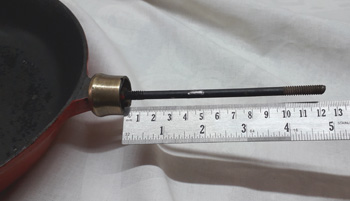 |
|
If you order a handle for one of these pans (regardless of the pan branding), I will be asking you for one accurate measurement.
With the bolt screwed fully in and the ferrule fitted right up to the pan, I will want to know the distance from the rear face of the ferrule to the end of the bolt.
In this example, the measurement is 122mm. |
|
| |
| |
In April 2021 I had an enquiry from Katherine Rushmore in New Zealand. Her Salter pan had been dropped, and the (aluminium ??) ferrule had split open. The question put to me was fairly normal, "can you do anything with this?"
As always, my natural response was "yes, I'll give it a go". I could not find a supplier for a replacement ferrule so I made a replacement handle using a plain band aluminium ferrule. I opened out the front end of the handle to ensure a good fit on the pan, and the result was well received. |
|
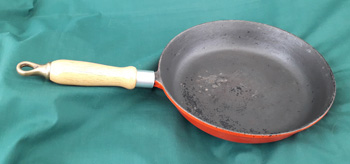 |
|
| |
| |
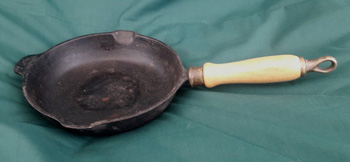 |
|
This Salter handle was done for Bethan Hughs as part of a bigger order in April 2021. |
|
| |
| |
| |
| |
| |
Aga Pan Handles |
|
|
|
| |
| |
| |
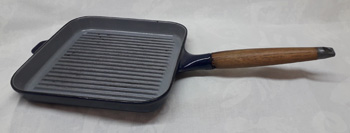 |
|
Similar to Salter pans, the Aga variants are either "branded" or "non-branded".
They have a long slim handle with a key slot cut into the front face, and normally, a cast aluminium loop fitting permenantly attached to the central bolt. |
|
| |
| |
Here you see the key section which is cast onto the back of the pan stem.
This fits into a matchig "key slot" cut into the front end of the handle. |
|
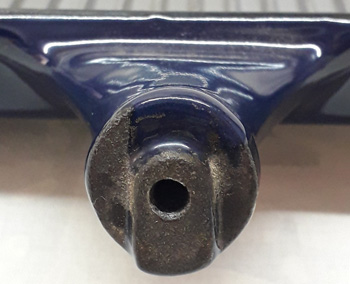 |
|
| |
| |
 |
|
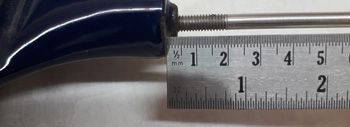 |
|
| |
| |
If you order a handle for one of these pans (regardless of whether the pan is or is not branded Aga), I will be asking you for one accurate measurement.
With the bolt screwed half way into the pan, I will want to know the distance from the rear face of the pan stem to the front face of the loop fitting. The right hand picture above shows you where to measure from.
In this example, the measurement is 152mm. |
|
| |
| |
 |
|
In August 2021 I had an enquiry from Ben Flynn, also in New Zealand. His Aga pan needed a new handle.
The replacement was made and sent out within a day or so of the original query coming in. Within a week the new handle went half way round the world and was fitted by a happy customer.
This picture shows the all important cut out at the front end of the handle which matches the key section on the pan stem. |
|
| |
| |
|
 |
|